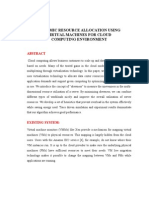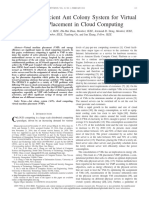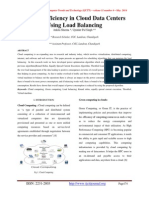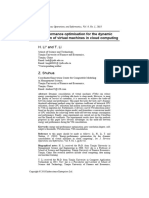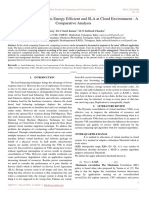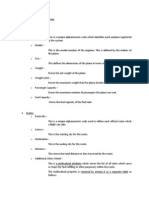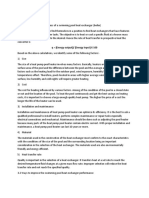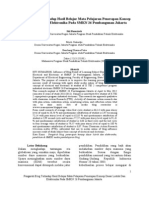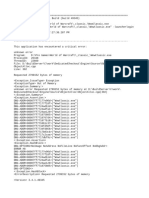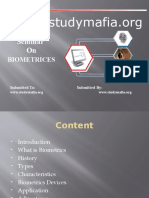0 ratings0% found this document useful (0 votes)
42 viewsOptimized Energy Efficient Resource Management in Cloud Data Center
Optimized Energy Efficient Resource Management in Cloud Data Center
Uploaded by
Himadri Bhattacharjeecloud
Copyright:
© All Rights Reserved
Available Formats
Download as PDF, TXT or read online from Scribd
Optimized Energy Efficient Resource Management in Cloud Data Center
Optimized Energy Efficient Resource Management in Cloud Data Center
Uploaded by
Himadri Bhattacharjee0 ratings0% found this document useful (0 votes)
42 views2 pagescloud
Original Title
V3I7-0298
Copyright
© © All Rights Reserved
Available Formats
PDF, TXT or read online from Scribd
Share this document
Did you find this document useful?
Is this content inappropriate?
cloud
Copyright:
© All Rights Reserved
Available Formats
Download as PDF, TXT or read online from Scribd
Download as pdf or txt
0 ratings0% found this document useful (0 votes)
42 views2 pagesOptimized Energy Efficient Resource Management in Cloud Data Center
Optimized Energy Efficient Resource Management in Cloud Data Center
Uploaded by
Himadri Bhattacharjeecloud
Copyright:
© All Rights Reserved
Available Formats
Download as PDF, TXT or read online from Scribd
Download as pdf or txt
You are on page 1of 2
2013, IJ ARCSSE All Rights Reserved Page | 436
Volume 3, Issue 7, July 2013 ISSN: 2277 128X
International Journal of Advanced Research in
Computer Science and Software Engineering
Research Paper
Available online at: www.ijarcsse.com
Optimized Energy Efficient Resource Management in
Cloud Data Center
Jagjeet Singh
1
1
Research Scholar,
Shri Guru Granth Sahib World University,
Fatehgarh Sahib, India
Sarpreet Singh
2
2
Associate Professor, Dept of Computer Science,
Shri Guru Granth Sahib World University,
Fatehgarh Sahib, India
Abstract: Prompt growth of the demand for computational power has led to the creation of large-scale data centers. They
consume enormous amounts of electrical power resulting in high operational costs and carbon dioxide emissions.
Moreover, modern Cloud computing environments have to provide high Quality of Service (QoS) for their customers
resulting in the necessity to deal with power-performance trade-off. We propose an efficient resource management policy
for virtualized Cloud data centers. Proposed scheme Consider task scheduling algorithm and the maximum and minimum
utilization threshold value. If the utilization of CPU for a host falls below the minimum threshold, all VMs have to be
migrated from this host and the host has to be switched off in order to eliminate idle power consumption. If utilization
goes over maximum threshold value then we migrate VMs from the host according to minimum cpu utilization We
present evaluation results showing that dynamic reallocation of VMs brings substantial energy savings, thus justifying
further development of the proposed policy.
Keywords: Efficient Energy, CPU Utilization, Virtualization, Allocation of virtual machines, CloudSim,
I. Introduction
In recent years, IT infrastructures continue to grow rapidly driven by the demand for computational power created by modern
compute-intensive business and scientific applications. However, a large-scale computing infrastructure consumes enormous
amounts of electrical power leading to operational costs that exceed the cost of the infrastructure in few years. For example,
in 2006 the cost of electricity consumed by IT infrastructures in US was estimated as 4.5billion dollars and tends to double by
2011 [1]. Except for overwhelming operational costs, high power consumption results in reduced system reliability and
devices lifetime due to overheating. Another problem is significant CO2emissions that contribute to the greenhouse effect
.One of the ways to reduce power consumption by a datacenter is to apply virtualization technology. This technology allows
one to consolidate several servers to one physical node as Virtual Machines (VMs) reducing the amount of the hardware in
use. Recently emerged Cloud computing paradigm influences virtualization and provides on-demand resource provisioning
over the Internet on a pay-as-you go basis [2]. This allows enterprises to drop the costs of maintenance of their own
computing environment and outsource the computational needs to the Cloud. It is essential for Cloud providers to offer
reliable Quality of Service(QoS) for the customers that is negotiated in terms of Service Level Agreements (SLA), e.g.
throughput, response time. Therefore, to ensure efficient resource management and provide higher utilization of resources,
Cloud providers(e.g. Amazon EC2) have to deal with power-performance trade-off, as aggressive consolidation of VMs can
lead to performance loss. Based on the trends from American Society of Heating, Refrigerating and Air-Conditioning
Engineers (ASHRAE), it has been estimated that by 2014 infrastructure and energy costs would contribute about 75%,
whereas IT would contribute just25% to the overall cost of operating a data center [3].
II. Related Work
In related study, a scheme for selecting energy efficient allocation of virtual machines in cloud data center. This scheme
consider the maximum and minimum utilization threshold value. If the utilization of CPU for a host falls below the lower
threshold, all VMs have to be migrated from this host and the host has to be switched off in order to eliminate idle power
consumption. If the utilization goes over the upper threshold, some VMs have to be migrated from the host to reduce
utilization to prevent potential SLA violation. We propose three policies for choosing VMs that have to be migrated from the
host: (1) Minimization of Migrations(MM) migrating the least number of VMs to minimize migration overhead; (2)
Highest Potential Growth (HPG) migrating VMs that have the lowest usage of CPU relatively to requested in order to
minimize total potential increase of the utilization and SLA violation; (3) Random Choice (RC) migrating the necessary
number of VMs by picking them according to a uniformly distributed random variable[4].
Singh et al., International J ournal of Advanced Research in Computer Science and Software Engineering 3(7),
J uly - 2013, pp. 436-437
2013, IJ ARCSSE All Rights Reserved Page | 437
III . Proposed Heuristic
Our proposed heuristic using a Task scheduling algorithm that schedule the tasks to the Vms according to cpu power.
According to our concept if tasks are scheduled to the Vms earlier, load is managed in a better way and this result in less
number of Vms migrations. Further migration of vms is considered with lowest usage of CPU and tasks are totally
dependent on it. This process is helpful to minimize total potential increase of the utilization and SLA violation. For
validation of our proposed work, we simulate Non Power Aware policy, MM and DVFS, Comparison has been done
with these two schemes.
In this scheme we used following task scheduling algorithm:
1. St ar t Al gor i thm.
2. Sor t the l i st of t he cl oudl et s ( t asks) on the basi s of t he si ze of cl oudl et s.
3. Loop whi l e t her e ar e cl oudl et s t o be schedul ed.
4. Pi ck t he cl oudl et C (i ) fr om the l i st .
Wher e i = {1, 2, 3, . . . . . . . . . . . . . . , n}.
5. Fi nd the Vm V(j) that may r un the cl oudl et successful l y.
Wher e j={1, 2, 3, . . . . . . . . . . . . . , m}.
6. Bi nd Vm V(j) t o the Cl oudl et C(i ).
7. If t her e ar e mor e cl oudl et s i n the li st , go t o st ep t hr ee.
8. Ret urn contr ol t o t he si mul at i on.
IV. Eval uati on
The proposed heuristics have been evaluated by simulation using CloudSim toolkit [5].The simulated data Centre includes 5
hosts .Each node is demonstrated to have One CPU core with performance equivalent to 3000,2660,2500,1000,2000 MIPS,4
GB RAM and 1 TB of storage. For the benchmark policies we simulated Non Power Aware policy (NPA), Minimum
Migration (MM) and DVFS that adjusts the voltage and frequency of CPU according to current utilization.
The simulation results presented in Table 1 show that Minimum CPU Utilization (MCU) policy brings higher energy savings
compared MM, NPA and DVFS policies.
Table 1
Simulation Results
Policy Energy SLA Migr. Overall SLA
MCU 0.03 kwh 0.002% 2 0.07%
MM 0.05 kwh 0.011% 13 0.16%
NPA 0.17 kwh 0.261% 13 0.85%
DVFS 0.09 kwh 0 0 0
V. Conclusion and future scope
In this work our proposed and evaluated heuristics minimize energy consumption, while providing reliable QoS. The
obtained results show that the technique of task scheduling and minimum usage of cpu brings substantial energy savings and
is applicable to real-world Cloud datacenters. For the future work, we propose to investigate of setting the utilization
thresholds dynamically according to a current set of VMs allocated to a host, propose to investigate optimization over
multiple system resources in VMs reallocation policies, such as RAM and network bandwidth utilization.
References
[1] R. Brown et al., Report to congress on server and data center energy efficiency: Public law 109-431, Lawrence
Berkeley National Laboratory, 2008.
[2] R. Buyya, C. S. Yeo, and S. Venugopal, Market-oriented cloud computing: Vision, hype, and reality for delivering it
services as computing utilities, in Proceedings of HPCC08. IEEECS Press, Los Alamitos, CA, USA, 2008.
[3] A. Beloglazov and R. Buyya, Energy Efficient Resource Management in Virtualized CloudData Centers, 10th
IEEE/ACM International Conference on Cluster, Cloud and Grid Computing,2010.
[4] A. Beloglazov and R. Buyya, Energy Efficient Allocation of Virtual Machines in Cloud Data Centers, 10th
IEEE/ACM International Conference on Cluster, Cloud and Grid Computing,2010.
[5] R. Buyya, R. Ranjan, and R. N. Calheiros, Modeling and simulation of scalable cloud computing environments and
the CloudSim toolkit: Challenges and opportunities, in Proceedings of HPCS09. IEEE Press, NY, USA, 2009.
You might also like
- Dynamic Resource Allocation Using Virtual MachinesDocument5 pagesDynamic Resource Allocation Using Virtual MachinesSaibaba GunturiNo ratings yet
- Rational Unified Process: Best Practices For Software Development TeamsDocument21 pagesRational Unified Process: Best Practices For Software Development TeamsCristal NgoNo ratings yet
- Compal Confidential: B3ZMS MB Schematic DocumentDocument45 pagesCompal Confidential: B3ZMS MB Schematic DocumentManggoloNo ratings yet
- Multi-Engine Submarine Power SuppliesDocument14 pagesMulti-Engine Submarine Power Suppliesdavid2404100% (2)
- SLA Formule Enegy EfficientDocument25 pagesSLA Formule Enegy Efficientriad bouaitaNo ratings yet
- 01 - 1 - Minimize SLA Violation and Power Consumption in Cloud Data Center Using Adaptive Energy Aware AlgorithmDocument15 pages01 - 1 - Minimize SLA Violation and Power Consumption in Cloud Data Center Using Adaptive Energy Aware AlgorithmhasniNo ratings yet
- Structure-Aware Online Virtual Machine Consolidationfor Datacenter Energy Improvement in Cloud ComputiDocument16 pagesStructure-Aware Online Virtual Machine Consolidationfor Datacenter Energy Improvement in Cloud ComputihasniNo ratings yet
- PowerDocument14 pagesPowerE-bookNo ratings yet
- 1024-Article Text-5071-1-10-20240315Document19 pages1024-Article Text-5071-1-10-20240315jebaevaNo ratings yet
- Abstract Cloud Computing Is An Emerging Paradigm That Provides ComputingDocument8 pagesAbstract Cloud Computing Is An Emerging Paradigm That Provides ComputingSudhansu Shekhar PatraNo ratings yet
- Dynamic Energy Management in Cloud Data Centers A SurveyDocument14 pagesDynamic Energy Management in Cloud Data Centers A SurveyAnonymous roqsSNZNo ratings yet
- Multi-Factor Max Correlation Algorithm For Fault Tolerance in Cloud Simulated EnvironmentDocument4 pagesMulti-Factor Max Correlation Algorithm For Fault Tolerance in Cloud Simulated EnvironmentijsretNo ratings yet
- Greencloud: A Packet-Level Simulator of Energy-Aware Cloud Computing Data CentersDocument21 pagesGreencloud: A Packet-Level Simulator of Energy-Aware Cloud Computing Data CentersAlieska WayeNo ratings yet
- Greencloud: A Packet-Level Simulator of Energy-Aware Cloud Computing Data CentersDocument21 pagesGreencloud: A Packet-Level Simulator of Energy-Aware Cloud Computing Data CentersAmirullahNo ratings yet
- ACO 307 Fois 2018Document16 pagesACO 307 Fois 2018riad bouaitaNo ratings yet
- Power and Performance Management of Virtualized Computing Environments Via Lookahead ControlDocument24 pagesPower and Performance Management of Virtualized Computing Environments Via Lookahead ControlYogendra SinghNo ratings yet
- Energy Efficiency in Cloud Data Centers Using Load BalancingDocument8 pagesEnergy Efficiency in Cloud Data Centers Using Load BalancingseventhsensegroupNo ratings yet
- Performance-to-Power Ratio Aware Virtual Machine (VM) Allocation in Energy-Efficient CloudsDocument10 pagesPerformance-to-Power Ratio Aware Virtual Machine (VM) Allocation in Energy-Efficient CloudsyekoyesewNo ratings yet
- Self-Optimization of Energy-Efficient Cloud ResourcesDocument14 pagesSelf-Optimization of Energy-Efficient Cloud Resourcessushil@irdNo ratings yet
- Simulator WalaDocument6 pagesSimulator WalaDhruv AswalNo ratings yet
- A Green Energy-Efficient Scheduling Algorithm Using The DVFS Technique For Cloud DatacentersDocument7 pagesA Green Energy-Efficient Scheduling Algorithm Using The DVFS Technique For Cloud DatacentersDenner Stevens100% (1)
- Virtual Machine Consolidation With Minimization ofDocument13 pagesVirtual Machine Consolidation With Minimization ofBarış CanözNo ratings yet
- Paper 6Document5 pagesPaper 6siyaxe8406No ratings yet
- 20211csd0086 Phanikiran 5csd01Document4 pages20211csd0086 Phanikiran 5csd01shashankjk4No ratings yet
- Optimal Frequency 1-S2.0-S2210537916301755-Am - s0Document24 pagesOptimal Frequency 1-S2.0-S2210537916301755-Am - s0ausiasllorencNo ratings yet
- Semi 3Document5 pagesSemi 3Sahana P HNo ratings yet
- An Efficient Resource Utilization Technique For Scheduling Scientific Workload in Cloud Computing EnvironmentDocument12 pagesAn Efficient Resource Utilization Technique For Scheduling Scientific Workload in Cloud Computing EnvironmentIAES IJAINo ratings yet
- Allocating Virtual Machines exploring Type-2 Fuzzy Logic and Admissible OrdersDocument6 pagesAllocating Virtual Machines exploring Type-2 Fuzzy Logic and Admissible Orderssigeri4340No ratings yet
- Katz 2009Document9 pagesKatz 2009kitape tokoNo ratings yet
- Energy Efficient Data Center Networks - A SDN Based ApproachDocument3 pagesEnergy Efficient Data Center Networks - A SDN Based ApproachAnish Kumar SahaNo ratings yet
- Ijcet: International Journal of Computer Engineering & Technology (Ijcet)Document5 pagesIjcet: International Journal of Computer Engineering & Technology (Ijcet)IAEME PublicationNo ratings yet
- Beloglazov 2011Document24 pagesBeloglazov 2011javadhitman1998No ratings yet
- Block Chain: A Pathway To Improve Performance Measures of Supply ChainDocument21 pagesBlock Chain: A Pathway To Improve Performance Measures of Supply ChainreenajainNo ratings yet
- 10.1007@s11227 020 03562 XDocument20 pages10.1007@s11227 020 03562 Xraheleh mohammadi913No ratings yet
- CloudDocument2 pagesCloudSumaiya Sadia BristyNo ratings yet
- Energy - Optimized Virtual Machine Scheduling Schemes in Cloud EnvironmentDocument5 pagesEnergy - Optimized Virtual Machine Scheduling Schemes in Cloud EnvironmentDrGhanshyam ParmarNo ratings yet
- Efficient Fault Tolerant Cost Optimized Approach For Scientific Workflow Via Optimal Replication Technique Within Cloud Computing EcosystemDocument11 pagesEfficient Fault Tolerant Cost Optimized Approach For Scientific Workflow Via Optimal Replication Technique Within Cloud Computing EcosystemIAES IJAINo ratings yet
- A Review On Energy Efficient Cloud Computing AlgorithmsDocument5 pagesA Review On Energy Efficient Cloud Computing AlgorithmsInternational Journal of Application or Innovation in Engineering & ManagementNo ratings yet
- An Efficient Green Control Algorithm in CloudDocument11 pagesAn Efficient Green Control Algorithm in CloudsanthoshNo ratings yet
- Eui Seong 2008Document13 pagesEui Seong 2008Armin AhmadzadehNo ratings yet
- Green Computing ReportDocument50 pagesGreen Computing Reportmanisha patilNo ratings yet
- 2 1520673200 - 10-03-2018 PDFDocument8 pages2 1520673200 - 10-03-2018 PDFEditor IJRITCCNo ratings yet
- Workload Consolidation Using VM Selection and Plac PDFDocument5 pagesWorkload Consolidation Using VM Selection and Plac PDFRukshanda kamranNo ratings yet
- Sorted Vms and Pms and Saving State of PM On Allocation of VM For The Cloud Infrastructure ServicesDocument6 pagesSorted Vms and Pms and Saving State of PM On Allocation of VM For The Cloud Infrastructure ServicesInternational Journal of Application or Innovation in Engineering & ManagementNo ratings yet
- Energy Criticality Avoidance-Based Delay MinimizatDocument19 pagesEnergy Criticality Avoidance-Based Delay Minimizatbeznik5353No ratings yet
- Towards Energy-Aware Scheduling in Data Centers Using Machine LearningDocument10 pagesTowards Energy-Aware Scheduling in Data Centers Using Machine LearningKevin MondragonNo ratings yet
- Green Operating System: Future Low Power Operating SystemDocument4 pagesGreen Operating System: Future Low Power Operating SystemVinay KumarNo ratings yet
- Review On Machine Learning For Resource Usage Cost Optimization in Cloud ComputingDocument7 pagesReview On Machine Learning For Resource Usage Cost Optimization in Cloud ComputingIJRASETPublicationsNo ratings yet
- Internet Technology Letters - 2020 - G - Efficient Task Optimization Algorithm For Green Computing in CloudDocument6 pagesInternet Technology Letters - 2020 - G - Efficient Task Optimization Algorithm For Green Computing in Cloudakshat patelNo ratings yet
- Approximate Single Precision Floating Point Adder For Low Power ApplicationsDocument15 pagesApproximate Single Precision Floating Point Adder For Low Power ApplicationsIJRES teamNo ratings yet
- Ijetae 0312 01Document6 pagesIjetae 0312 01rosita61No ratings yet
- An Optimal Cloud Resource Provisioning (OCRP) Algorithm On-Demand and Reservation PlansDocument5 pagesAn Optimal Cloud Resource Provisioning (OCRP) Algorithm On-Demand and Reservation PlansIJRASETPublicationsNo ratings yet
- Genetic Algorithm Based Optimization Technique For Power Management in Heterogeneous Multi-Tier Web ClustersDocument7 pagesGenetic Algorithm Based Optimization Technique For Power Management in Heterogeneous Multi-Tier Web ClustersInternational Journal of Application or Innovation in Engineering & ManagementNo ratings yet
- Roba MulDocument56 pagesRoba MulNishitha NishiNo ratings yet
- 494-Article Text-1970-1-4-20201110Document27 pages494-Article Text-1970-1-4-20201110Daniela Beltrán SaavedraNo ratings yet
- Green Cloud: Published On Nov 15, 2015Document2 pagesGreen Cloud: Published On Nov 15, 2015Biju KuttanNo ratings yet
- A Prediction Based Energy Conserving Resources Allocation SchemeDocument19 pagesA Prediction Based Energy Conserving Resources Allocation SchemeBala GaneshNo ratings yet
- Optimized Ant Colony System (Oacs) For Effective Load Balancing in Cloud ComputingDocument6 pagesOptimized Ant Colony System (Oacs) For Effective Load Balancing in Cloud ComputingInternational Journal of Application or Innovation in Engineering & ManagementNo ratings yet
- (IJCST-V4I3P11) : Abhinav Thorat, Prof. Shrinivas SonkarDocument5 pages(IJCST-V4I3P11) : Abhinav Thorat, Prof. Shrinivas SonkarEighthSenseGroupNo ratings yet
- IOSR JournalsDocument8 pagesIOSR JournalsInternational Organization of Scientific Research (IOSR)No ratings yet
- Clustering Based Virtual Machines Placement in Distributed Cloud ComputingDocument20 pagesClustering Based Virtual Machines Placement in Distributed Cloud ComputingMoatez Hassan KhalilNo ratings yet
- Energy Efficient High Performance Processors: Recent Approaches for Designing Green High Performance ComputingFrom EverandEnergy Efficient High Performance Processors: Recent Approaches for Designing Green High Performance ComputingNo ratings yet
- Model-Driven Online Capacity Management for Component-Based Software SystemsFrom EverandModel-Driven Online Capacity Management for Component-Based Software SystemsNo ratings yet
- LEACH Ad HocDocument10 pagesLEACH Ad HocHimadri BhattacharjeeNo ratings yet
- Class Data Flow AnalysisDocument44 pagesClass Data Flow AnalysisHimadri BhattacharjeeNo ratings yet
- Resource Allocation in Cloud Computing: A ReviewDocument4 pagesResource Allocation in Cloud Computing: A ReviewHimadri BhattacharjeeNo ratings yet
- Resource Allocation and Storage Using Hungarian Method in Mobile Cloud ComputingDocument5 pagesResource Allocation and Storage Using Hungarian Method in Mobile Cloud ComputingHimadri BhattacharjeeNo ratings yet
- Entities and Their PropertiesDocument9 pagesEntities and Their PropertiesHimadri BhattacharjeeNo ratings yet
- Super Long Front: An Attachments Reach No LimitsDocument8 pagesSuper Long Front: An Attachments Reach No Limitsandie.notoNo ratings yet
- Custom UrlDocument11 pagesCustom UrlAchmad FaizNo ratings yet
- Chapter 1. What Is Linux?: 1.1. HistoryDocument1 pageChapter 1. What Is Linux?: 1.1. Historykeasca asNo ratings yet
- Adding Narration To Powerpoint SlidesDocument5 pagesAdding Narration To Powerpoint SlidesMOTHERS JOY EDUCATIONAL CONSULTANCY SERVICESNo ratings yet
- q3.CSS 9 Week 5Document8 pagesq3.CSS 9 Week 5Ramlede BenosaNo ratings yet
- International Sales Business Development Manager in San Diego CA Resume Christopher TyreeDocument2 pagesInternational Sales Business Development Manager in San Diego CA Resume Christopher TyreeChristopherTyreeNo ratings yet
- St-Eclipse Model E2xx/3xx-xLx L-Bracket Mounted DSP-Based Digital Servo DrivesDocument3 pagesSt-Eclipse Model E2xx/3xx-xLx L-Bracket Mounted DSP-Based Digital Servo DrivesRchrdStrkNo ratings yet
- Final System DocumentationDocument31 pagesFinal System DocumentationEunice AquinoNo ratings yet
- 01 - Arithmetic Formatter - LearnDocument2 pages01 - Arithmetic Formatter - Learncodestudent405No ratings yet
- Edoc 001864Document52 pagesEdoc 001864leesger7No ratings yet
- Dynamic Perception NMX Motion Controller: User GuideDocument27 pagesDynamic Perception NMX Motion Controller: User GuideAnonymous 9NQAZO3sNo ratings yet
- η = (Energy output) / (Energy input) X 100Document2 pagesη = (Energy output) / (Energy input) X 100muhd fikriNo ratings yet
- Supply Chain Management Unit 2Document7 pagesSupply Chain Management Unit 2shubham singhNo ratings yet
- ICT Security Policy PDFDocument39 pagesICT Security Policy PDFSamaira KhanNo ratings yet
- Pengaruh Blog Terhadap Hasil Belajar Mata Pelajaran Penerapan Konsep Dasar Listrik Dan Elektronika Pada SMKN 26 Pembangunan JakartaDocument13 pagesPengaruh Blog Terhadap Hasil Belajar Mata Pelajaran Penerapan Konsep Dasar Listrik Dan Elektronika Pada SMKN 26 Pembangunan JakartaRendy Aditya PangestuNo ratings yet
- Agile PMDocument5 pagesAgile PMSatyamNo ratings yet
- KX-FP701FX: Operating InstructionsDocument56 pagesKX-FP701FX: Operating InstructionswinaryantoNo ratings yet
- 2023-05-27 19.27.36 Error - 26348Document34 pages2023-05-27 19.27.36 Error - 26348mitimaexNo ratings yet
- Business Process Mapping and ModelingDocument34 pagesBusiness Process Mapping and ModelingVitalii LiakhNo ratings yet
- VSL 2024 Course List and Loan Caps (Students)Document14 pagesVSL 2024 Course List and Loan Caps (Students)ashishkumar777No ratings yet
- Ect301 Linear Integrated Circuits, December 2022Document2 pagesEct301 Linear Integrated Circuits, December 2022Dinil DhananjayanNo ratings yet
- Capstone 1Document4 pagesCapstone 1Donna Mhae CarasNo ratings yet
- Ninja 250 Fi 2018 Standart Non Abs Ex250sjfin PDFDocument99 pagesNinja 250 Fi 2018 Standart Non Abs Ex250sjfin PDFaryvhidayatNo ratings yet
- Intro To Fdmee: Presented by Justin D'Onofrio & Joe StasiDocument32 pagesIntro To Fdmee: Presented by Justin D'Onofrio & Joe Stasisen2nat100% (1)
- BiometricsDocument20 pagesBiometricsMonika MataiNo ratings yet
- Agile MedicalDocument11 pagesAgile MedicalYousra El MeriniNo ratings yet
- LCD Monitor TV: Service ManualDocument45 pagesLCD Monitor TV: Service ManualIvanLugoNo ratings yet
